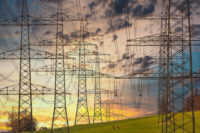On Aug. 21, the US solar eclipse was set to keep the sun from fully powering 1,900 utility-scale solar photovoltaic plants across the country, leading to a shortfall of up to 21,650 megawatts of solar power. But just as they do every night when the sun goes down or when clouds cover the sun, the grid operators handled the rapid ramping up and down of solar power by turning to other types of power.
The California Independent System Operator, which manages the California grid, had no problems with the rapid drop of solar power of 70 to 80 MW of generation per minute during the height of the eclipse in the state. Indeed, the change was minor compared with the 13,000 MW drop in solar power that the grid operator has had to manage when the sun goes down.
“This is a totally predictable event,” says Chuck Ladd, engineering manager of renewable energy for Black & Veatch. “I’m pretty skeptical that any eclipse is going to be worse than cloud cover,” adding that it is not uncommon for cloud cover to cause solar power to be reduced from full power to 20 percent in a matter of seconds.
The eclipse, however, does illustrate the growing need to manage the intermittent nature of renewables such as solar or wind. Grid operators have become adept at managing the current-level intermittent power provided by wind and solar. But that may become more difficult as the percentage of solar and wind power increases on the system. Solar supplies 13 percent of California’s power now, but the state is set to be 100-percent renewable by 2045.
In Black & Veatch’s Aug. 15-released “Strategic Directions: Electric Industry Report,” 43 percent of the utilities that responded to the annual survey said they planned to add solar generation in the next five years, and 42 percent planned to add wind. Only 2 percent of respondents said they planned to add coal, while another 34 percent said they would add natural-gas plants.
"We’re going to need to deal with this as we increase our renewable generation," Ladd says. "The eclipse is only one of the events that we need to prepare for."
The North American Electric Reliability Council concluded in a white paper in advance of the eclipse that industry collaboration and regulatory requirements will be necessary to better integrate solar, wind and other distributed energy resources in the future. NERC says the impact of an eclipse on a nation with a higher level of solar power will be "more relevant" in 2024, when the next solar eclipse occurs over North America.
Ladd says more automatic controls and energy storage, such as batteries, are two options that can be used to help manage the intermittent resources.
The Energy Dept.’s Energy Information Administration said of the 21,650 MW that was partially obscured by the sun during the two hours at the peak of the eclipse on Aug. 21, just 70 MW was totally obscured during the eclipse, while 4,000 MW, largely in North Carolina and Georgia, received just 10 percent of the sun’s power during the eclipse. But solar makes up just 3 percent of the North Carolina’s electricity.
In California the California Independent System prepared a set of 12 “tools” to handle the shift in generation, including transferring power from other grids and asking homeowners to pledge to reduce their energy use during the eclipse to “give the sun a break.”




